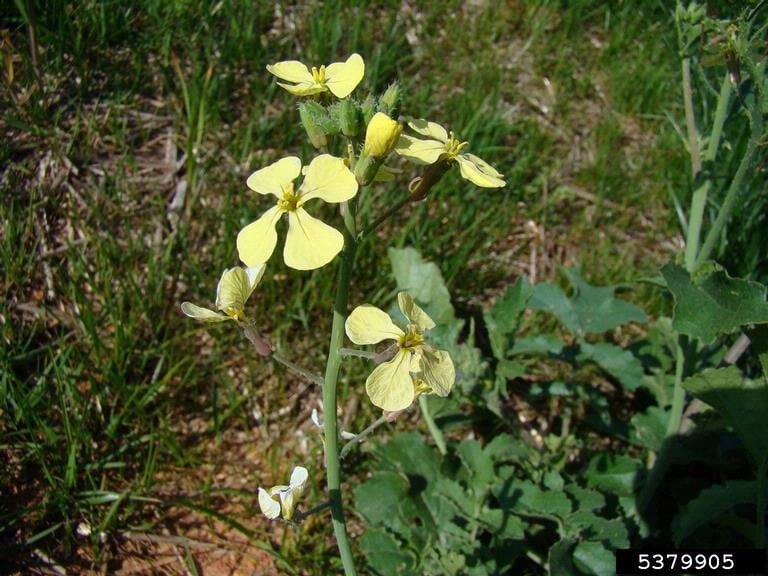Wild radish (Raphanus raphanistrum) is a weed of both field crops and vegetable fields. In New York, it emerges mainly in the spring (summer annual), although in warmer regions it emerges largely in the fall and winter, and over-winters as a rosette (winter annual). Wild radish can occur in any soil type, but is most competitive in nutrient-rich and acidic sandy soils.
Wild Radish is one of 3000+ species in the mustard family. For help identifying weedy mustards either in the rosette or flowering phase, please visit our mustard identification page.
Identification
Seedlings: Wild radish cotyledons are heart- to kidney-shaped with purple hairy stems and long petioles. Early leaves are rough and hairy, with irregular, wavy, and lobed margins with irregular teeth. The tip of these leaves are the largest segment, with 2-4 smaller lobes towards the base of the leaf. These leaves form a basal rosette.
Leaves: Mature plant leaves are are alternate with have toothed edges. Lower leaves are oval to oblong with long leaf stems (petioles) and the same shape as early leaves. They grow up to 20 cm (8”) long by 5 cm (2”) wide. These leaves form on long petioles and have a large terminal lobe. Upper leaves are smaller, have little or no petiole, and are more lance shaped with 0-5 lobes. All leaves have stiff hairs on top, bottom, and edges.
Mature plant:
Flowering stems develop branches and grow from the basal rosette. They have stiff hairs, especially towards the lower portions of the stem. Flowers emerge in June and continue to bloom through September. Wild radish has a thick taproot that smells strongly of radish.
Flowers/Fruit: The light yellow flowers are made up of 4 petals with purple veins and hairy sepals. Over time, the yellow petals begin fading to white. Some individuals have pink to purple flowers rather than yellow. Flowers grow on short flower-stalks (pedicels) up to 5-20 mm (4/5”) long. The long, narrow seedpods (siliques) are 2-4 cm (~1.6”) long with a 1-3 cm (up t0 1.2”) beak-like tip. Lower seedpods may be smaller. Seeds are 2-3 mm (~1/10”) long by 1.5-2 mm (~3/5”) wide, egg-shaped, and dotted with tiny light brown to black spots.
Management
Chemical control
In New York, Butyrac 200 does not control wild radish, which is why it’s so important to identify this weed in soybean, alfalfa, or trefoil fields. New York specific guidance can be found in the Cornell Crop and Pest Management Guides, or click above for the chemical control of wild radish from Cornell’s turfgrass and weed identification app.
Wild radish herbicide resistance has not been identified in North America, but Group 2 (ALS inhibitors like metsulfuron) resistance has been found on three contenents. In Australia, resistance to five groups – Groups 2, 4 (synthetic auxins like dicamba and triclopyr), 5 (photosystem II inhibitors like atrazine), 9 (glyphosate), and 12 (PDS inhibitors like fluridone and norflurazone) have all been found. Given this history, watch this species closely and report any apparent resistance.
Non-chemical control
Wild radish produces abundant and long-lived seed, so any management will take time to show results. With time, this species can be effectively treated using mechanical management. Shallow tillage several days before planting followed by final fit of the field to remove emerged seedlings can reduce spring populations of wild mustard; cultivation with stiff tine weeders, very close cultivation with shallow sweeps, and hilling corn and soy all can help with weed management. If hand-pulling, it is important to remove the majority of the weed’s root system. Wild radish is most competitive in acidic and high-nitrogen soils; liming your field to a pH of about 6.8 can help reduce competition from this species.
Biological control with red-legged earth mite, cabbage moth, white Italian snail, Rutherglen bug, or thrips can help with controlling wild radish infestations but are not sufficient to exterminate the weed. These insects either feed on or damage the plant.
Climate Change Considerations
Wild radish shows a more vigorous seedset when grown on moist soils, and less vigorous seed set when grown on drier soils. The environment that the mother plant grows in can help determine how vigorous the next year’s radish problem will be; with climate change increasing precipitation in NYS, wild radish may become a more problematic weed.
Species Similar to Wild Radish
Table 1: Shows wild radish (Raphanus raphanistrum) similarities and differences in identification compared to its similar species .| Species | Similarities | Differences |
|---|---|---|
| Yellow rocket (Barbarea vulgaris) | dark green leaves, yellow flowers | hairless leaves |
| Wild mustard (Brassica kaber) | dark green leaves, highly lobed leaves arranged in a basal rosette, yellow flowers, erect stems | leaves are not as deeply lobed (typically won't reach back to the midvein like many wild radish leaves), bright yellow flowers, hairless leaves |
References
Uva R H, Neal J C, DiTomaso J M. 1997. Weeds of the Northeast. Book published by Cornell University, Ithaca NY. The go-to for weed ID in the Northeast; look for a new edition sometime in 2019.
Wild Radish profile from Weed ID Guide via University of Missouri’s Division of Plant Sciences. Concise identification information and images for wild radish.
Organic management suggestions except for biological control are from Dr. Charles Mohler of Cornell University. Look for an upcoming book from Dr. Mohler on ecological management of weeds, from Cornell University Press.
University of California, Davis’s Weed Report from Weed Control in Natural Areas in the Western United States. Identification and management information on wild radish.
Campbell, L.G. et al. (2015) ‘Maternal environment influences propagule pressure of an invasive plant, raphanus raphanistrum (brassicaceae)’, International Journal of Plant Sciences, 176(4), pp. 393–403. doi:10.1086/680683.








